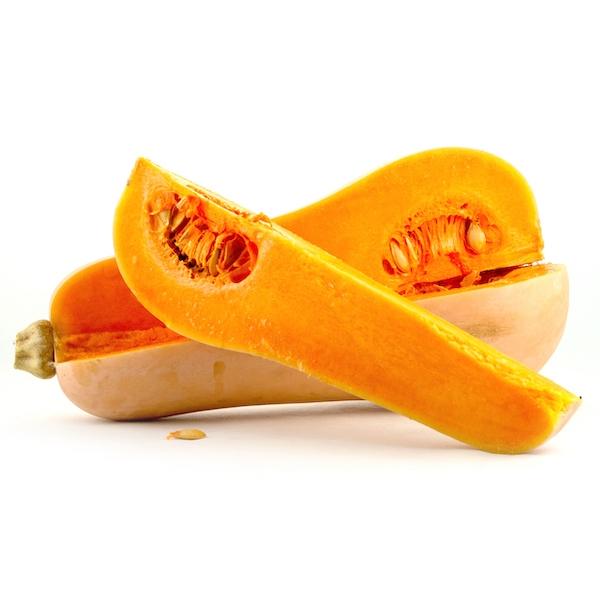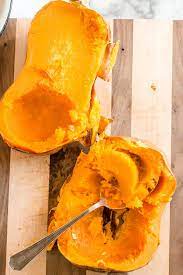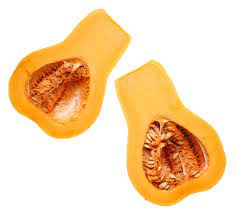Squash flesh refers to the edible portion or interior of a squash, which is a type of vegetable typically grown in gardens and used in various culinary dishes. Squash flesh is the soft, inner part of the squash that can be cooked and eaten in different ways, such as roasting, steaming, mashing, or using it as an ingredient in soups, stews, casseroles, and salads.
There are various types of squash, each with its own unique flavor, texture, and color of flesh. Some popular types of squash include butternut squash, acorn squash, spaghetti squash, and pumpkin. The flesh of these squashes can vary in color from orange to yellow to beige, and they often have a slightly sweet and nutty flavor.
To prepare squash flesh for consumption, the squash is typically cut open, and the seeds and fibers inside are removed. The remaining flesh is then cooked according to the desired recipe or method. Squash is a versatile vegetable and can be used in both savory and sweet dishes, making it a popular choice in many cuisines around the world.
The Economic Importance and Uses of Squash Flesh

Squash, a popular vegetable, has several economic and practical uses due to its nutritional value and versatility in cooking.
Here are the economic importance and uses of squash flesh:
1. Cooking: Squash flesh is often used in various culinary dishes, including soups, stews, curries, casseroles, and stir-fries. Its mild flavor and versatile texture make it suitable for a wide range of recipes.
2. Baking: Squash flesh can be roasted, baked, or steamed and used in baking recipes for bread, muffins, pies, and cakes, providing natural sweetness and moisture to the baked goods.
3. Processed Foods: Squash flesh can be processed into canned purees, baby food, sauces, and other convenience food products. This adds value to the vegetable and provides an ingredient for different food items.
4. Health Products: Squash flesh can be used to create nutritional supplements, such as powders or capsules, which can be consumed as a dietary supplement to provide essential vitamins and minerals.
5. Livestock and Poultry Feed: Squash flesh can be used as feed for livestock and poultry, providing a source of nutrients for their growth and health. This can be a cost-effective option for farmers.
6. Organic Fertilizer: Squash flesh, along with other organic kitchen waste, can be composted to create nutrient-rich organic fertilizers that can be used to enhance soil fertility and support plant growth.
7. Biogas Generation: Squash flesh can be used as a substrate for biogas production through anaerobic digestion, providing an eco-friendly source of renewable energy.
8. Charitable Contributions: Squash flesh can be donated to food banks or used in community initiatives to provide nutritious meals to those in need, contributing to food security and addressing hunger issues.
9. Farmers’ Market Sales: The production and sale of squash flesh at farmers’ markets and local grocery stores can contribute to the local economy by generating income for farmers and supporting agricultural trade.
The Products and By-products That Can Be Derived From Squash Flesh

Squash is a versatile vegetable that can be used to create various products and by-products, both in culinary and non-culinary applications.
Here are some of the products and by-products that can be derived from squash flesh:
1. Squash Puree or Mash: Squash flesh can be cooked and mashed to create a smooth puree or mash. This can be used as a base for soups, sauces, baby food, or as a side dish.
2. Squash Soup: Squash puree can be used as the main ingredient for making delicious squash soups, often flavored with spices and herbs.
3. Squash Slices or Cubes: Squash flesh can be sliced or cubed for roasting, grilling, sautéing, or using in stir-fries.
4. Squash Chips: Thinly sliced squash can be baked or dehydrated to create crispy squash chips, a healthy snack alternative.
5. Squash Fritters or Patties: Squash flesh can be mixed with other ingredients like flour, eggs, herbs, and spices to make fritters or patties which can be fried or baked.
6. Squash Bread or Muffins: Squash puree or grated squash can be used to make bread, muffins, or other baked goods, adding moisture and nutrition.
7. Squash Jam or Chutney: Cooked squash flesh can be used to make jams or chutneys by adding sugar, spices, and other flavorings.
8. Squash Beverages: Squash puree can be used to make smoothies, juices, or even squash-flavored drinks by blending with other fruits or ingredients.
9. Squash Seeds: Squash seeds can be roasted and seasoned to create a nutritious and tasty snack.
10. Squash Oil: Squash seeds can be pressed to extract oil, which can be used for cooking or as a dressing in salads.
11. Squash Flour: Dried and ground squash can be used to create squash flour, which can be incorporated into various recipes for added nutrition.
12. Squash Skin Scraps (Compost): The skin and other inedible parts of the squash can be composted to enrich soil and support sustainable gardening.
13. Squash Stock or Broth: The peels and other parts of squash not used in cooking can be simmered to create a flavorful vegetable stock or broth.
14. Squash-Based Face Masks or Skin Treatments: Squash pulp can be used in DIY face masks or skin treatments due to its moisturizing and antioxidant properties.
15. Squash Feed for Animals: Inedible parts of squash can be used as feed for animals, reducing waste and contributing to animal nutrition.
In conclusion, squash flesh has a range of economic benefits and practical uses, including dietary consumption, culinary applications, food processing, animal feed, organic fertilizer, biogas production, food donations, and contributions to the local economy.
Read Also: How to Make Money from Glass Wastes

